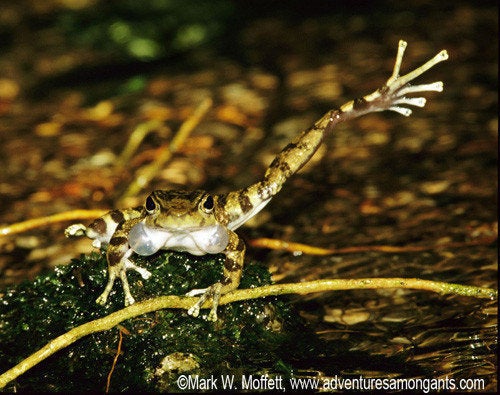
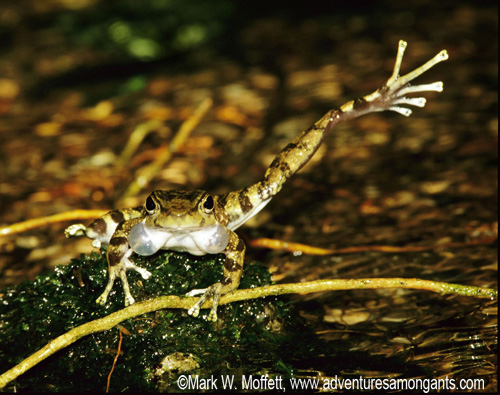
Ecologist and explorer Mark Moffett was in Brazil trying to get a photograph of a frog dancing. Honest. He says no one had ever done it before. Unfortunately, the frog seemed to have significant performance anxiety when faced with a camera. So Moffett's first move was to treat the very small frog "as if he was a leopard." Moffett hid behind "a stone," he says and waited. Eventually, a female frog came along and hopped on Moffett's shoulder. The male quickly went into his mating dance wiggling his fingers on one side while kicking his leg on the other. Oo la la. The photo when into a National Geographic book for children Moffett wrote. Check out the video below -- from his talk at the Annenberg Space for Photography -- for more.
Normally, as a writer, I work alone. But Mark Moffett was such a delight to interview - I saw him before he presented an IRIS lecture at the Annenberg Space for Photography in Los Angeles - that I have decided to let him tell this story as much as possible.
First, let me introduce you to the man. Some salient points:
- He believes that photography is just a way of telling a story. Yet, his photographs of ants are "the best ever taken," according to esteemed Harvard biologist E.O. Wilson and his recent book Adventures Among the Ants, was described by the novelist Margaret Atwood as "spectacular."
All I can say is - with ignorance like that who needs education?
Well, he did, apparently, of a very self-directed kind. He went to get his doctorate from Harvard (under the guidance of Prof. Wilson), but soon left on a 29-month research trip to India and Asia to write his dissertation. National Geographic Magazine, which has published about 500 of his photographs, calls him the "Indiana Jones of entomology", and in person he has a distracted, other-worldly quality and a wicked sense of comic timing.
He has a rare, intuitive understanding of creatures, says his wife Melissa Wells, that is enhanced with a scientist's close and patient observation. Though he can seem off in his own world thinking about something, he is in fact far more down-to-earth than any of us, spending most of his time researching ants with his cheek in the dirt, only one inch away from his subjects.
Here's a short video from Voice of America television about his 2009 exhibit at the Smithsonian called "Farmers, Warriors, Builders: The Hidden Life of Ants." ( Did I tell you he's a Research Associate in Entymology at the Smithsonian?)
The Tree Climber
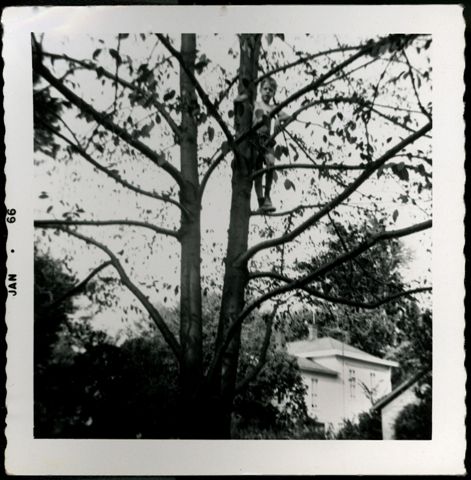
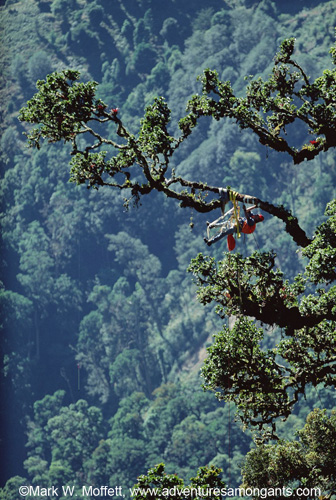
Moffett spent considerable quality time with trees in his youth, fascinated with the natural world. (Photo on left by Don Moffett, Mark's dad.) Later, it came in handy as he researched his book The High Frontier -- Exploring the Rainforest Canopy. Who says we have to give up the pursuits of youth?
"You just don't stop doing things... I started off as a very shy boy. And I went to graduate school because the only thing I knew how to do was biology, was ecology. I knew creatures and I had an intuitive sense of how to deal with them, too. And almost by accident I fell upon photography as a tool to prove the behavior I was documenting. And then I started showing pictures. Got the skill of actually talking about them in front of groups. And now National Geographic gets me in front of groups of thousands of people. I've been on Conan and Colbert which is absurd to people who knew me as a graduate student. ... Last year, I went and did stand-up at the World Science Festival in New York. It was tremendously fun. When I'm told I shouldn't do something, I just want to try it. It's like I went forward not paying attention to people and now people pay me money for doing the same thing I did as a kid.
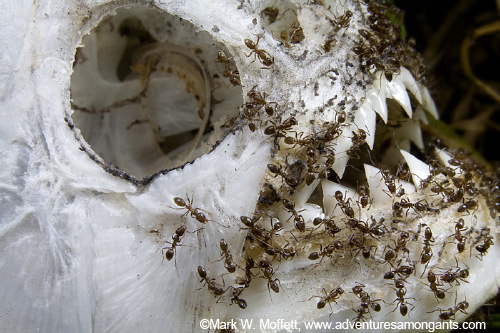
Argentine ants are not to be trifled with -- as this piranha found out. The bad news is Argentine ants are spreading -- there are hundreds of billions of the six-legged biters on the American west coast between San Francisco and the Mexican border. The aggressive Argentines have wiped out indigenous ant species . Moffett says the largest known battlefield in the world is just outside San Diego where four enormous colonies of Argentine ants are constantly at battle with each other. He says overall there are perhaps 20,000 species of ants -- more than birds -- and that ants outnumber humans a million to one. Kind of makes you wonder what might happen if they decided to throw their numbers around.
Image as Story
"Photography is just a way of telling a story... Sometimes I find people are so overwhelmed with the gear that the stories get lost in the process. So you'll see otherwise great photographers and their pictures are great ... but I'm like -- Where' s the story? ... Maybe the the picture is enough sometimes. But I want to see a thread in the story. ...Basically, for me the camera is a microscope... So you're looking through a microscope - if something cool happens, you press the button. It isn't about photography, it's about capturing moments."
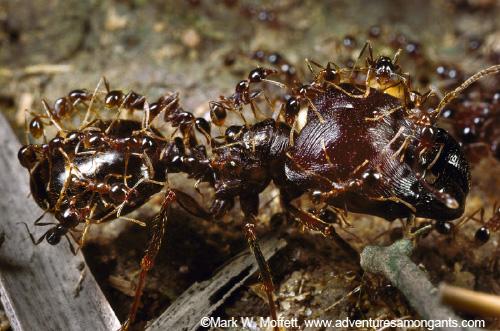
Size matters. These are all marauder ants. One colony will have different sized workers to do different jobs. The big one here - about a quarter of an inch long - acts as a bus to take the smaller ants out to fight battles and secure prey. By the way, even the little guys pack a painful bite.
Photographing Ants as Supermodels
"I was a loner who liked the backwoods. So basically, as a graduate student I got out into the field as fast as I could, into tropical Asia. And I decided to travel as long as I could because my money didn't last long at Harvard, but in India -- you'd be surprised -- I lived the first six months on a $100 travellers check.
"I eventually stayed for two and a half years on this one trip. In that sense, I had the most laidback thesis of all time. But I I didn't want to come home and discover that no one believed my stories and thought I had hung around smoking dope with a guru or something. So I figured out how to take pictures before I left. I got a book on photographing supermodels and it mentioned these kinds of light [hair light, fill light] and I got an old Cannon camera and an old lens that I reverse-mounted and all these different pieces that I cobbled together - flashes that I got for $12 each -- and those flashes would give me shocks in the field alll the time - but I could actually start taking pictures with about $250 worth of equipment. I eventually shot my first four or five National Geographic stories with that same gear.
"The astonishing part is that when I left Harvard to go to India - I eventually traveled to 19 countries -- I had actually never photographed a live ant before. I'd photographed dead specimens on a gray card. In the middle of winter . In Boston. Went to India and started taking my very first pictures of live ants. I didn't have any money. I eventually took 6 rolls of pictures. Because I had a small National Geographic grant, they offered to develop my film. I sent it off and got back a telex -- which is called an email now. It said that National Geographic was going to fly someone out to talk to me. I hadn't even seen my pictures of the ants at this point. [And yet those first rolls provided the shots for his first story published in the magazine!]
Have Sex and Die -- A Guy's Life
Moffett addressed the male ant's minimal role in ant colonies at his Annenberg lecture, but it wasn't as succinct as his version on NPR's Fresh Air. So with thanks to National Public Radio, here goes:
"The guys don't really do too much. They're kind of kicked out of the society soon after they're born. They have a single function: to have sex. OK. They have two functions. To have sex and die. And apparently that's satisfactory for them. They don't participate in the social life."
Falling in Love With Things You Don't Expect
Some one once asked Clyde Butcher, the black and white photographer known for his iconic nature shots, why he never took photos of the garbage in the Everglades. Butcher said he felt his role was to be positive, to record the natural world so that people would know there was something worth saving. When I put this to Moffett, he nodded:
"Exactly. We have similar point of view. There's too much negative perspective ... One of the truths I've found is that conservation is a really important message to get across, but people are overwhelmed with all this negativity. And it's not very interesting. Even I turn off the stories on TV ... You have to remind people why they should be falling in love with things they don't expect. If you do that, maybe they'll go out and start saving things."
But as many of us know, falling in love -- even with an insect -- is not without risks. Here's a video excerpt his wife and videographer Melissa Wells shot while studying ants in Angkor Wat, Cambodia.
As an explorer and scientist, Moffett has visited every country in tropical Asia and Latin America and most countries in Africa. He spends his time searching out and observing creatures and sometimes discovering new ones. Wikipedia says he's found a number of new ant species on his travels and has a frog, a beetle and an ant named after him. His science, his exploration and his art all flow from the same source -- understanding.
"If you go around the world and gather enough information on these creatures, you can actually have more interesting interactions with them ... I think there is a mind in an ant. It's not necessarily doing a lot, but once you understand the mind of an ant, you start taking pictures [that capture] a certain energy and pose ... Whereas many people's pictures will make the same creatures look dead.
"[Imagine] a martian landing on this planet taking photos of Thanksgiving dinner, the pictures would be horrifying. The people would probably look dead... I think whatever your subject is you have to have this empathy...
"There's a heck of a lot of bad insect art. If you have enough color in a beetle you can publish it anywhere. But you add that level of understanding and then you can show its personality. [With this understanding,] you know how a story unfolds. ... So I tell people who want to get into nature photography to get a degree in biology. Learn the story first."
Ants are more like Humans than Chimpanzees
"Operating on a mass level very efficiently, ants are more like people than chimpanzees are like people. This is one of the messages of the book ... Only ants have societies that go up into the millions and have to deal with traffic problems and public hygiene and infrastructure and all these other things. [Like warfare.] ... Ants end up being a lot like us, but they work very efficiently possibly because they are not like us. They work for the common good rather than, like us, have [a situation where] millions of families living together with different interests. Ants have this more united common ground and a common national identity that make them very fierce competitors...
"And we're actually getting more and more ant-like because of things like the Internet and tweeting and texting - equal opportunity to exchange information the way the ants do without a hierarchy. The hierarchy stuff with leaders came late in our evolution. We did not have that [early on in human society]. Anyone who was too annoying and tried to have too much power would be ousted by a small tribe.... It's called reverse dominance hierarchy. So ants have had this equality thing that we started with and now we're going back, overturning [governments] by tweeting. That is ant-like power."
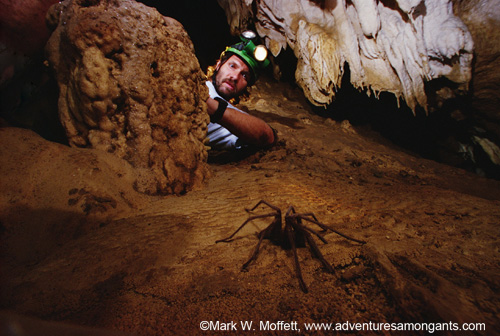
Moffett says he took this photo after discovering giant blind tarantulas in an Aztec burial chamber in a cave in Oaxaca, Mexico. "My expertise is finding things that haven't been seen before," he explained when telling the story. Just after the photo was taken, Mark's guide, Peter Sprouse, found the tarantula running up his pants leg. "What do I do?" Peter said. "Don't hurt it. It's endangered," replied Moffett. Unfortunately, the spider did not show a similar respect for the unendangered species called humanity. The big, blind, hairy guy bit the guide -- who survived.
Scary Moments
No, the scariest moment wasn't with the rather large tarantula above.
"I've had very nervous moments in the field. And I've been around all kinds of things people think are dangerous. But when it comes to adrenaline moments, walking out on stage for Colbert was as scary as sitting on a venomous snake, which I've done."
(It was in Peru. Moffett accidently approached the New World's most deadly snake, the fer-de-lance bottom-first. Moffett survived, he says, by unwittingly sitting on the snake's head --"which if you think about it is the only correct way to sit on a fer-de-lance.")
Love & Happiness
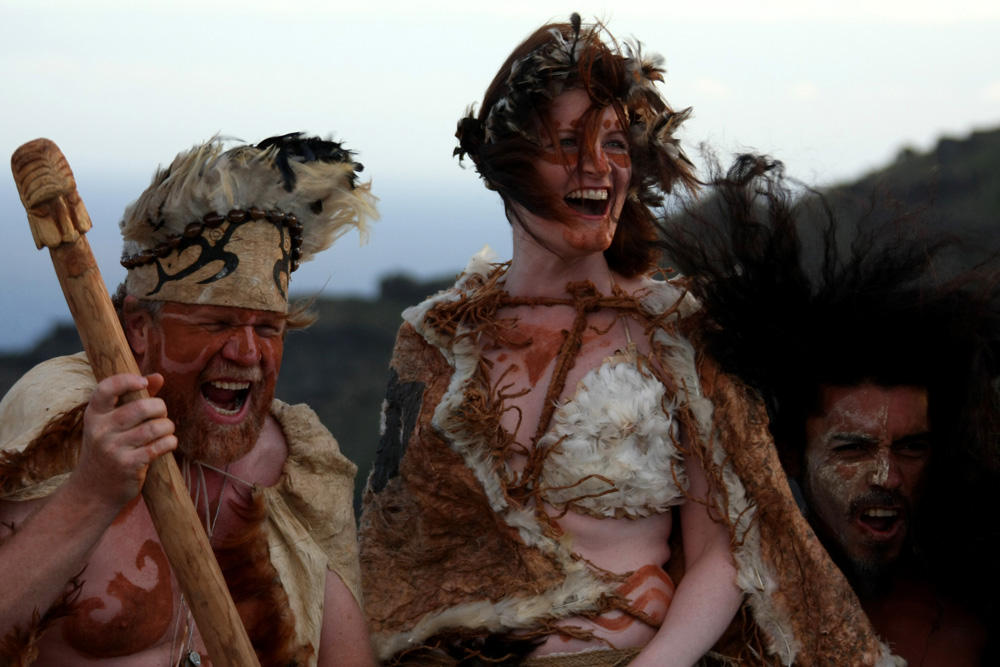
(c) Mike Hawley. Moffett and Melissa Wells discovered that facepaint, as well as love, becomes them, on their wedding day on Easter Island. A fitting exotic venue for the nuptials of man who has visited pretty much everywhere on earth except certain parts of the Congo and Pittsburgh.
I had the good fortune to talk to Moffett and Wells about their relationship and partnership -- she goes on the trips and directs his video segments. Their mutual insight and honesty is remarkable.
Mark: We relate to the world through our senses. So it's all sensory moments as far as I'm concerned. If you go to a place and you have an ultimate moment with an environment , with a creature or with a sunset and you can connect with someone -- this is the ultimate reason to get married because you can share these things. [The experience is ] so much greater. You have this history of these moments.
Me: How did you two meet?
Mark: Well we met through a friend of Melissa's who told me about her. Melissa was working in the medical field. She put together teaching hospitals .... But she also loves travel to remote places.
Melissa: Our first date, Mark walked me back and we passed a man walking a dog ... I commented on the man's expression and Mark knew exactly what the dog was thinking. And I realized that's how we approached the world... Part of the reason he spends time alone is that his strength is his ability to relate to creatures. From an ant to a frog to a mammal he has a very intuitive sense of what motivates them and why they are doing what they're doing and what they're experiencing...He doesn't see one creature as more valuable than another.
Me: So you are complementary?
Melissa: Yes. We see the world from different perspectives and there are literally times when we are both speaking English and neither of us have any idea what the other has said. So we step back and break it down in monosyllabic pieces.
Mark: I do feel like a blind man who needs Melissa for guidance. She rounds out the human side, she explains what our species is doing.
Point of View
I asked Moffett what it was like for someone who describes himself as a loner to study a species that is so focused on the mass identity and living in a way that seems, well, crowded.
"Maybe I started as a kid jealous of ants because you can see that they're social. That's what you notice as a child. All of us started studying ants [when we were young] because we were close to the ground ... We watched ants because they're doing all these things that were fascinating compared with for example the average squirrel, which is pretty asocial when compared to an ant or a human.
"Most animals don't do much. Ants are constantly interacting -- building things like trails or houses, fighting - all things humans do. All the time. Never a moment's gap ... So much action, you learn very fast. ... People ask me why I watch ants, I ask them why they ever stopped."
Disclosure #1: I did a deal with Mark that I would put up an image of the cover of his recent book if he let me use his photos. Thanks, Mark. We're even now.
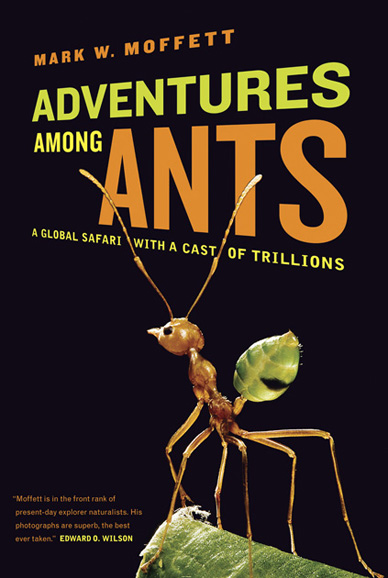
Disclosure #2: Huffington Post is a sponsor of the current exhibition running at the Annenberg Space for Photography -- "Extreme Exposure."
